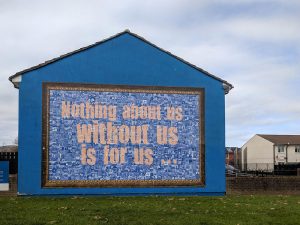Editor’s Note: Sandra Mikush is assistant director of the Mary Reynolds Babcock Foundation, Bernie Mazyck is president and CEO of the South Carolina Association of CDCs, and Reverend Charles Malloy is executive director of the Community Development Corporation of Marlborough County in Bennettsville, SC. The following stories highlight the rich and fruitful relationships between these three groups — foundation, infrastructure organization, and local nonprofit — and with the larger networks of which they are a part.
Sandra Mikush describes Mary Reynolds Babcock Foundation’s grantmaking as “very deliberatively regionally focused.” The Babcock Foundation makes grants in 12 states in the Southeast and pays particular attention to building long-term capacity, not only in local organizations but also in the statewide and regional organizations that support them.
At the Babcock Foundation, our primary point of investment is in local organizations, but these organizations are often enormously enriched by regional and national infrastructure organizations. These infrastructure groups help seed local organizations and nurture them, over time supporting their growth and development while connecting them to best practices and linking them to resources.
Our experience in South Carolina is a good illustration: Community development corporations (CDCs) in South Carolina have come into being only over the last decade and their development reflects the potential and power of national, statewide, and local infrastructure. Our relationship with the South Carolina Association of CDCs (SCACDC) started when we made a grant to The Community Foundation in Charleston. They had a small neighborhood grants program and were trying to develop the capacity of emerging neighborhood groups to be at the table with more established organizations in the community. They sent a delegation to look at the community economic development industry in North Carolina, and it seeded the idea that local, community-based nonprofits could be players in community economic development. It didn’t go unnoticed that key to North Carolina’s success was statewide infrastructure that included public and private funding and institutional and technical assistance to local CDCs.
Bernie Mazyck led the delegation to North Carolina as a staff member of the community foundation but soon thereafter founded the SCACDC. Ten years ago, South Carolina only had one or two CDCs working locally. The association now has 45 members and is building an infrastructure with training, technical assistance, and state tax credits for community development. The Babcock Foundation has made grants directly to several local CDCs and supported SCACDC to organize local CDC leaders to advocate for public support for the community development industry.
The South Carolina work is spilling over beyond CDCs to advance broader rural development goals. SCACDC has been working closely with the South Carolina Association for Non-Profit Organizations (SCANPO) to strengthen local CDCs. And through the Southeastern Organizational Development Initiative, both organizations began talking and strengthening their relationships with SC Fair Share, a statewide advocacy organization, and two initiatives at Clemson University. These five different types of organizations had been working in silos on grassroots leadership, nonprofit support, and rural development, but they recognized they could increase their own effectiveness and meet local needs through a coordinated effort. So they are now working together. They have several funders in the state willing to support joint planning so the various approaches to nonprofit support and rural development are more integrated and effective.
Bernie Mazyck is the president and CEO of the South Carolina Association of Community Development Corporations, a trade association that links nonprofit economic development organizations in South Carolina. SCACDC epitomizes the skill and responsiveness of an effective local infrastructure organization. It creates a politically friendly and resource-rich environment, and scouts the country to locate promising new models that help the organizations it works with get to where they want to be in the future.
First, I’d like to tell you about one of our members, a community development corporation in Marlborough County, South Carolina. In this case, they first invited us to come to a community meeting. They didn’t know about Community Development Corporations (CDCs) per se, but they did know that something existed that enabled communities to come together and create an economy for the community. They just didn’t know exactly how.
We gave them some ideas of what they could work on and we said, “If this is something you want to do and you want to organize, we’re there to support you.” They then identified leaders in the community, created a board, and said, “This is what we want to do. Can you help us?” We helped them with board development. We helped them design programs and projects. They attended trainings, which we provide for community development corporations in South Carolina, and there they learned everything from organizational development to project and program development.
They signed on to the Individual Development Account (IDA) program, which is another program we offer to our members. They went on to get certification for state CDC tax credits through an accreditation program that we pushed through the state legislature some years ago. As a result, they now have investors seeking them out.
This CDC is only three years old, but we like to point to it as an excellent example of an organization just starting out. Not that we have all the answers, but we think if you follow some of these steps you’re going to be able to create a pretty solid organization on the ground.
Now, to back away a bit, I’ll tell you who we are and how we support the CDCs we work with. We were established about ten years ago by four CDCs who were looking to create an infrastructure of support. We started by working with state policy-makers to develop policy backing for CDCs. Banks were also some of our earliest supporters because they recognized the value of the relationship between CDCs and community lenders.
The intent of our organization is to work with community-based, community-controlled organizations. This is somewhat different from some other states where CDCs have been developed by banks or by local government. We put particular emphasis on empowering local communities to create these entities themselves. That is harder to do, and takes a lot more time. It would be much easier if we were working in a well-heeled community with all the right players who bring the right resources together to make that happen, but that’s not what we were organized to do.
We do have members that are in less distressed areas, but we put particular emphasis, as far as our services are concerned, on those communities whose residents have come together to take action.
To do our work well, we’ve both created networks and become members of existing networks. We are members of a national trade association called the National Congress for Community and Economic Development. There, we learn from colleagues around the country about setting up membership structures, putting together quality conferences, and creating IDA programs for local members. We also look at how to work on policy in our states—from connecting to our congressional delegations to choosing which policies to tackle at the federal level.
Also, on a national level, we have the National Rural Funders Collaborative that has enabled us to connect and elevate our profile with funders like the Ford Foundation, the Casey Foundation, and the Heron Foundation. So that collaborative, that network, has strengthened our position in the eyes of our funders.
Sign up for our free newsletters
Subscribe to NPQ's newsletters to have our top stories delivered directly to your inbox.
By signing up, you agree to our privacy policy and terms of use, and to receive messages from NPQ and our partners.
We are also members of the state nonprofit association, South Carolina Association of Non-profit Associations (SCANPO) that connects us with our state legislators. We use the organizational development training that they provide, and we are also able to participate as part of a larger voice in the state that advocates for nonprofit organizations in general.
Membership in SCANPO helps to elevate the importance of nonprofits as players in advancing the state’s economy, creating jobs in the state, and attracting capital to the state. It also helps us to pass relevant legislation. For example, this year we’re working on finding a way to create some kind of health insurance pool for staff of nonprofit organizations.
To make the connection between the national and the local, I’d like to get back to the Marlboro County CDC. Simply having external resources doesn’t create effective organizations. Having an effective organization has a lot to do with local leadership. The executive director, Reverend Charles Malloy, has donated much of his time to making this happen. Such sacrifices that are made in the early stages, when added to the infrastructure investments we make, can bring about profound long-term benefits.
Reverend Charles Malloy is pastor of Robinson African Methodist Episcopal Zion Church in Cheraw, SC, and executive director of the Community Development Corporation of Marlboro County. Marlboro County has a population of 28,118, of which 52 percent is African-American. The unemployment rate is 18 percent, more than triple the national average. This rural county, first a farming community and then dependent on industry, is now losing its manufacturing jobs at an alarming rate. Some plants have moved to Mexico; others have simply phased out operations. Currently, the largest employer in Marlboro County is the state prison, and a new $33 million federal prison is slated to be built in the near future. The brand new county jail is already filled to capacity with employees and inmates.
Our mission at the Community Development Corporation of Marlboro County is to create housing, community and economic development, leadership and educational opportunities for the citizens of Marlboro County. The organization came into being through a series of community meetings with Bernie Mazyck and State Representative Douglas Jennings Jr. We explained our needs: We want all of our children to graduate from high school. We want to cut down on teenage pregnancy. We want to create a safe, healthy environment for our children to play. We want good affordable housing, not these trailer parks (Lord help me, I cry every time I pass by them). We want to see a good strong working community where all our organizations and agencies and elected officials work together to improve the lives of our citizens.
The association (SCACDC) really was key in getting us started. They provided board training, financial management training, and a small start-up stipend, which helped us pay the bills early on. They were also directly involved in securing two grants for us, one from Washington Mutual and another from the Babcock Foundation. And last year the SCACDC gave us a scholarship to the National Community Reinvestment Coalition conference. During that conference, we met Citicorp representatives and, as a result, we later received a grant from them.
More recently, the SCACDC is working very closely with the Department of Commerce and others to help us gather funding and initiate a $9 million project. The project is part of a larger project that includes a 32,000-square-foot, multi-use facility that will include community programs and business ventures — all aimed at providing jobs, training and recreational activities, especially for young people. This is very important to us because even when our kids go to college, they tend to leave the community because we don’t have enough high-skilled, high-paying jobs for them. With the help of the South Carolina Association of Community Development Corporations, we’ve begun an Independent Development Account (IDA) Program. The program provides three-to-one matching funds for use by those within the income guidelines to build a house, start a business, or continue their education. The program also includes a 30-hour course in what we call financial literacy.
These programs are critical. We have a high teen-age pregnancy rate which leads to a high dropout rate, and little vocational training. If we don’t make changes and begin to provide something better for our young people, we will not be able to attract new industry, and we may even lose what we already have.
I think it’s really about our children — educating them, housing them, and giving them opportunities. I remember a family I worked with that had something like 17 kids. They lived in a very small home and the kids were always in trouble at school. Only one had graduated from high school at the time. The Department of Social Service wanted to put all of them into foster care. I worked with the DSS director to come up with a solution for the family. We were able to provide more adequate housing for the family. Now some years later, one of them has her master’s degree. Others have graduated from high school and others are in college. Without adequate housing, without beds to sleep in, without a place to wash their clothes, these kids were just not able to succeed.
You see, I’m ex-military. I was in the United States Air Force for 21 years. The Lord has blessed me. I’ve been able to travel to many places around the globe. I’ve seen a lot of children and a lot of communities in this world. And so, I understand that unless you teach your children — house them, feed them, and help them to make changes in the community, the community will die. And communities die in a lot of different ways. But the bottom line is, if you don’t make a difference in your community there is a good chance of it becoming extinct. And the board and staff of the CDC is making every effort to not let that happen here, Lord help us.
by Sandra Mikush
Supporting nonprofit infrastructure in a region like the Southeast brings special challenges for us. The South has relatively few philanthropic resources and that means there has been little investment in building a nonprofit infrastructure. Only about half of the states have nonprofit associations, and the few management assistance organizations that exist are located in urban centers. Many of our grantees are local, grassroots groups working on social justice issues, either in low-wealth neighborhoods or rural counties. Traditional nonprofit training and support doesn’t work for them. Even if good training is available in their state, they may not be able to afford it, get to it, or be confident that it will be culturally-appropriate for their board and staff.
Ten years ago, we depended on groups like the Peace Development Fund and Center for Community Change to provide organizational development assistance to grassroots organizations in the South. In recent years, though, we’ve tried to focus our grants on developing infrastructure within the region. We’ve made grants to statewide centers for nonprofits in several southern states, assisting them to increase their own effectiveness and sustainability. We’ve also worked with several important groups that meet specific needs in the South: Southern Empowerment Project for organizing and grassroots fundraising training, Project South for action research and popular education, and the People’s Institute for dismantling racism work, to name a few.
Along with our grants, we’ve spent the time and money to convene our grantees during our annual Gathering, which is planned by grantees and focused on organizational development. This has become an important opportunity to provide access to quality training, build peer networks for ongoing support, and create a mutual learning environment with our grantees. The Gathering has heightened the collective awareness of groups across the region, many of which operate in isolation, about how they can work together and support each other.
Relationships from the Babcock network helped seed the Southeastern Organizational Development Initiative (SODI), whose goal is to create a long-range plan for meeting the organizational development needs of underserved organizations in the region. Networks of nonprofits, consultants, support organizations, and funders are beginning to work on statewide and sub-regional levels to build on existing infrastructure to improve non-profit support. It’s still a challenge to build infrastructure in the South, but now we have a lot of partners working with us.









